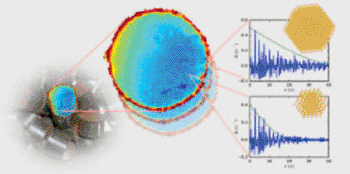Dual-Imaging Shows Internal Nanoscale Structure, Chemistry of Objects
By LabMedica International staff writers
Posted on 15 Oct 2013
Nanomaterials comprised of particles with dimensions measured in billionths of a meter hold vast potential for creating more effective fuel cells, batteries, catalysts, and drug-delivery systems. Posted on 15 Oct 2013
Seeing how nanostructured materials inside these devices evolve and interact as they operate is essential to gain clues into ways to optimize performance. However, most studies have looked at idealized samples of isolated components, not as they function in operating devices. A group of researchers at the US Department of Energy’s Brookhaven National Laboratory (Upton, NY, USA) and Columbia University’s (New York, NY, USA) School of Engineering and Applied Science has developed a new kind of “X-ray vision”—a way to peek inside actual devices to map the internal nanostructures and characteristics of the various components, and even track how properties evolve as the devices operate. The innovative dual imaging method described September 30, 2013, in the journal Nature Communications, combines high-intensity X-rays for discerning nanoscale structures with cross-sectional “slices” of the device to target the exact location of the nanostructured components. It creates new opportunities for developments in a wide range of research fields from materials science to biomaterials, geology, environmental science, and health.

Image: Peering inside a catalyst: A new dual-method imaging technique allowed scientists to map the internal nanostructure of these cylindrical catalyst bodies nondestructively. The technique combines computed tomography (CT), which makes “slices” of the 3D structure (circles), with X-ray particle distribution functions (PDFs, shown as graphs), to plot information about the internal nanostructure and chemistry (colors), pixel-by-pixel in three dimensions. The PDFs for the two pixels shown indicate that there are large palladium nanoparticles at the edge of catalyst body, and small palladium nanoparticles in the center (represented as different-sized clusters). The powerful method reveals the structure at many length scales—from the millimeter-scale catalyst body, to the micron-scale arrangements of the nanoparticles, to the billionths-of-a-meter nanoparticles, all the way down to the atoms themselves (Photo courtesy of Brookhaven National Laboratory)
“If you think of a battery with an anode, next to a membrane, next to a solid electrolyte, next to another membrane, next to the cathode, and all this wrapped in a steel container, it's pretty opaque from the outside,” said Dr. Simon Billinge, one of the paper’s lead authors and a researcher at both Brookhaven and Columbia Engineering. “What we can do now, with this new dual-imaging method, is look inside the battery and extract the nanostructure from each of those parts of the battery separately, and we can do it without taking the battery apart, and we can also do it while the battery is operating, to follow the chemistry as the materials evolve.”
The X-rays used for this technique are not like the ones used to image a broken bone. They are exquisitely intense, small beams with very high energy produced by a synchrotron light source, a precision scientific instrument located at select research centers around the world, including Brookhaven Lab and the European Synchrotron Radiation Facility (Grenoble, France), where this specific study was conducted. The X-rays generate measurements of the distribution of distances between pairs of atoms in the material, known as atomic pair distribution functions (PDFs), which reveal the nanoscale structure.
Larger scale cross-sectional images of slices of the material taken from multiple angles using computed tomography (CT)--similar to what clinicians use to identify brain injuries after a bad fall--give scientists the spatial data they need to make a three-dimensional (3D) map of the device’s material components and position the information about nanoscale structure on that map.
“Each method is powerful in its own right, but together they give us a whole new kind of picture,” Dr. Billinge said. “For the first time we can separate the nanostructure signals from the different parts of a working device and see what the atoms are doing in each place, without dismantling the object.”
Similar to the imaging methods that have had a huge impact in health care and the physiologic and neurologic sciences, this technique offers unprecedented access to the internal workings of materials at the nanoscale. To demonstrate the technique, the scientists constructed images of a complex phantom sample composed of a mixture of multiple amorphous and semi-crystalline compounds. They were able to tell these distinct phases apart with ease. Then they used the technique to examine the internal structure of a catalyst comprised of palladium nanoparticles on an aluminum oxide support that is widely used in the chemical industry.
“The efficiency of many industrial processes is dependent on the performance of catalysts deposited onto a structural support known as a catalytic body, so it’s extremely pertinent to understand how they are prepared and operate in practice,” Dr. Billinge said.
The technique clearly revealed a non-uniform distribution of particles, with larger particles on the surface and smaller ones on the inside of the material. “It is not clear from this study whether the significant catalytic activity would originate from the larger and more numerous particles located at the periphery, or by the smaller ones in the interior,” Dr. Billinge said. “But by using dynamic PDF-CT to monitor the catalyst as it performs, it is now possible to provide a more complete picture of the catalyst sample and the evolutionary processes by which it develops and operates to understand these relationships, and ultimately to guide improved catalyst design.”
This research was performed while Dr. Billinge was on sabbatical from Columbia and Brookhaven, but will likely continue at the US National Synchrotron Light Source II (NSLS-II) at Brookhaven, when it becomes operational in 2015. “With modern synchrotron light sources, sub-micron X-ray beams are becoming more widely available, allowing for the possibility of PDF-CT imaging with resolution on nanometer length-scales in the near future,” Dr. Billinge said.
Related Links:
Energy’s Brookhaven National Laboratory
Columbia University














